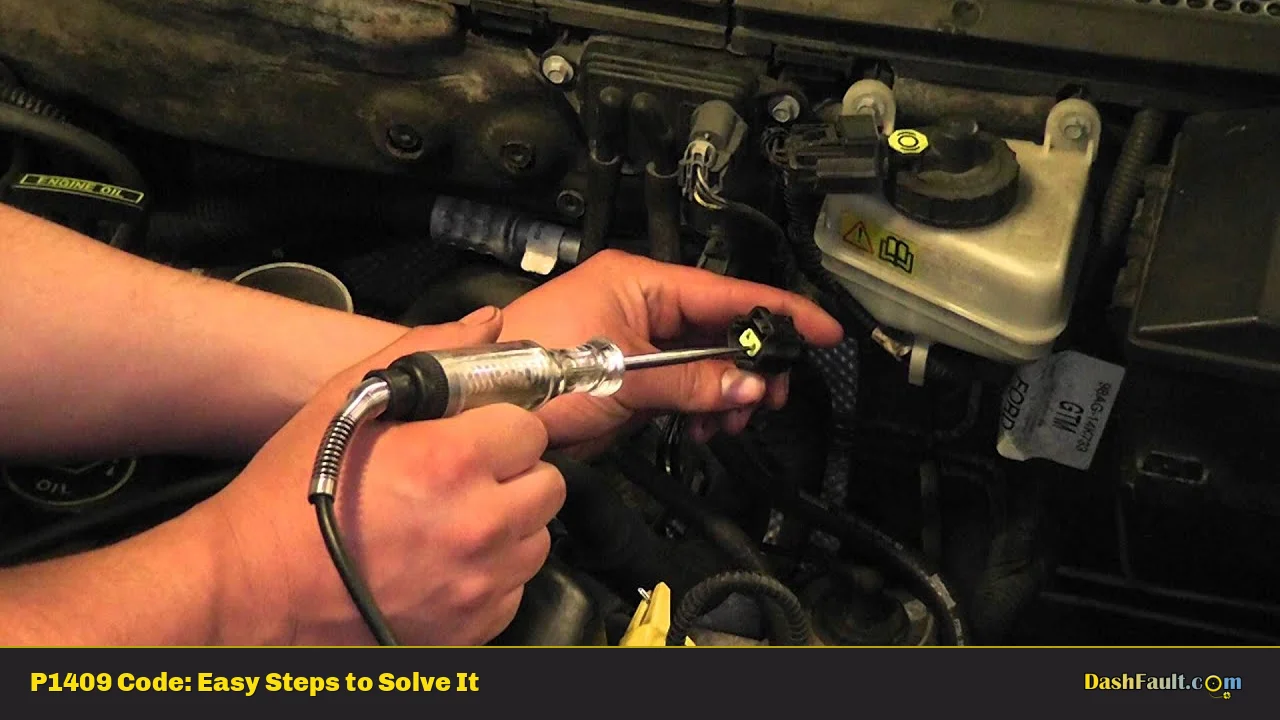The P1409 trouble code indicates a malfunction in the Exhaust Gas Recirculation (EGR) vacuum regulator solenoid circuit. This code is often specific to certain vehicle makes, particularly Ford, Lincoln, and Mercury models. When the Powertrain Control Module (PCM) detects an issue within the EGR system’s electrical circuit, it triggers this code. The EGR system is vital for controlling emissions by recirculating exhaust gases back into the engine’s intake manifold, thereby reducing combustion temperatures and nitrogen oxide (NOx) emissions. Understanding this code is crucial for vehicle owners and DIY mechanics as it can lead to decreased engine performance and increased emissions if not addressed promptly.
| P1409 Code Meaning | P1409 Code Common Causes |
|---|---|
| EGR Vacuum Regulator Solenoid Circuit Malfunction | Faulty EGR vacuum regulator solenoid |
| Electrical fault in the EGR system | Damaged or disconnected wiring and connectors |
| Insufficient vacuum supply to the EGR valve | Clogged or leaking vacuum lines |
| Malfunctioning EGR valve | Faulty PCM (rarely) |
Symptoms of P1409 Code
When the P1409 code is triggered, drivers may notice several symptoms that can impact vehicle performance:
- Check Engine Light: The most common indication of a trouble code.
- Reduced Engine Power: The vehicle may enter limp mode to protect the engine.
- Rough Idle or Stalling: Irregular engine performance at idle.
- Increased Fuel Consumption: Poor fuel efficiency due to improper air-fuel mixture.
- Failed Emissions Test: The vehicle may not pass emissions testing due to elevated NOx levels.
Technical Explanation
The P1409 code relates specifically to the EGR vacuum regulator solenoid, which is responsible for controlling the vacuum applied to the EGR valve. When the PCM detects an anomaly in this circuit—whether from electrical issues or component failures—it triggers the P1409 code. This can lead to improper functioning of the EGR system, resulting in higher emissions and potential engine performance issues.
The EGR system operates by allowing a portion of exhaust gas back into the intake manifold during combustion. This process helps lower combustion temperatures and reduces harmful NOx emissions. If there is a malfunction in this system, it can cause significant environmental and operational issues.
Step-by-Step Diagnosis
Diagnosing a P1409 trouble code involves several systematic steps:
- Visual Inspection:
- Check the EGR vacuum regulator solenoid, wiring, connectors, and vacuum hoses for visible damage or disconnections.
- Electrical Testing:
- Disconnect the EVR solenoid connector and use a multimeter to check resistance across its terminals. The typical resistance should be between 26-40 ohms. If readings are out of range, replace the solenoid.
- Vacuum Testing:
- With the engine running, use a vacuum gauge to check for vacuum at the EGR valve when commanded on by the EVR solenoid. No vacuum indicates a potential blockage or faulty solenoid.
- Power Supply Check:
- With the key on (engine off), check for 12V and ground at the EVR connector. If voltage is absent, trace back to the PCM to identify any open circuits or shorts.
- EGR Valve Inspection:
- Inspect the EGR valve for sticking or carbon buildup that could affect its operation.
Solution Methods
To resolve a P1409 code effectively, follow these solution methods:
- Replace Faulty Components:
- If testing reveals a faulty EVR solenoid or damaged wiring, replace these components as necessary.
- Repair Wiring Issues:
- Repair any damaged wires or connectors that may be causing an open circuit in the EVR circuit.
- Clear Codes and Test Drive:
- After repairs are made, clear the codes using an OBD-II scanner and take the vehicle for a test drive to ensure that no new codes appear.
Cost Estimates
The cost of addressing a P1409 trouble code can vary significantly based on labor rates and parts prices:
- EGR Vacuum Regulator Solenoid Replacement: $50 – $150
- Labor Costs: $75 – $150 per hour
- Total Estimated Cost: $125 – $300 depending on complexity and local rates.
Warnings and Recommendations
- Always ensure that repairs are conducted safely; disconnect battery power before working on electrical components.
- If you are unsure about any step of diagnosis or repair, consult with a professional mechanic to avoid further damage.
Closing Paragraph
Understanding and addressing a P1409 trouble code is crucial for maintaining your vehicle’s performance and compliance with emissions standards. By following systematic diagnostic steps and implementing necessary repairs, vehicle owners can effectively resolve this issue. Regular maintenance of the EGR system can prevent future occurrences of this code, ensuring optimal engine efficiency and reduced environmental impact.
Frequently Asked Questions About P1409
- What does error code P1409 mean?
P1409 indicates an issue with the EGR vacuum regulator solenoid circuit, affecting exhaust gas recirculation. - Can I drive my car with a P1409 code?
While it may be possible, it’s not recommended as it can lead to increased emissions and potential engine damage. - How do I reset a P1409 code?
You can reset it using an OBD-II scanner after making necessary repairs. - What are common symptoms associated with P1409?
Symptoms include check engine light illumination, reduced power, rough idling, and increased fuel consumption. - Is P1409 related to other trouble codes?
Yes, it may accompany other EGR-related codes like P0401 (Insufficient EGR Flow). - How serious is a P1409 code?
If left unaddressed, it can lead to significant engine performance issues and increased emissions. - Can I fix a P1409 code myself?
Yes, with proper tools and knowledge of automotive systems, many DIY mechanics can address this issue. - When should I seek professional help for a P1409 code?
If you are unable to diagnose or repair the issue after following troubleshooting steps, consult a professional mechanic.
